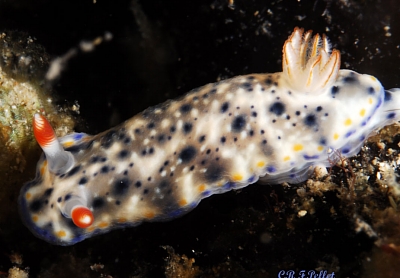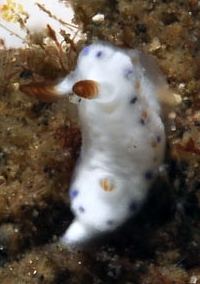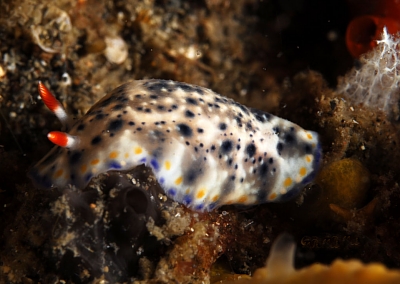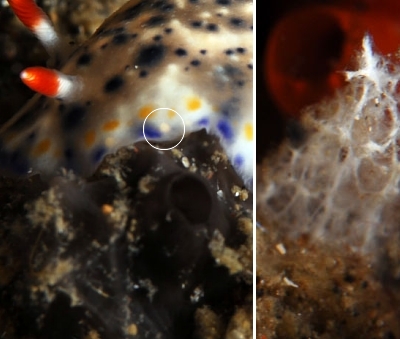Hypselodoris sagamiensis from Indonesia
October 17, 2007
From: F. & P. Pellet

Hi Bill,
After some hesitation, we have identified this nudibranch as Hypselodoris sagamiensis. We found it feeding on a black sponge (middle right photo). We would like to know if you agree with our ID.
Locality: Lembeh Straits, 12m, Indonesia, Celebes Sea, 26 09 2007, Sandy bottom . Length: 25 mm. Photographer: Francis Pellet.
We enclose also a picture of a 5 mm juvenile specimen (pic 3: depth 17m, Mawali Wreck, 28-Sept-2007) Could this be a juvenile of H.sagamiensis?
Thank you for your help once again.
Best Wishes
Francis & Pirjo
pirjo.pellet@free.fr



Dear Francis & Pirjo,
This is a nice find. Yes I agree its H. sagamiensis which is very interesting because it provides a link between what we thought was the "home range" of this species in the Sino-Japanese region of the north Pacific and the large populations Gary Cobb [#19421] has reported from southern Queensland in eastern Australia. It looks like this species, rather than being endemic to the north-eastern Pacific has a wider distribution at least in the tropical western Pacific. As I discuss in Gary Cobb's message, this has an interesting similarity to the way the distribution of H. maritima , which was initially considered a Japanese endemic, was extended firstly to eastern Australia and then the intervening region was gradually filled in.
Concerning the juvenile. With the usual hesitation in identifying juveniles, I am pretty sure this is also H. maritima.
Thanks also for the sponge photo. Dark coloured sponges are always a problem to interpret from photos as much of the detail is lost in the shadows. It certainly could be a species of Euryspongia but I can't be sure. While concentrating on the detail, I almost missed the whitish mass on the right side of your feeding photo. As you can see in the close-up, it is the fibrous skeleton of a dysideid sponge - probably the same as the one the Hypselodoris is eating. Although I can't be sure, it seems reasonable to assume that this slug has eaten the first bit and has now moved on to the next bit - they may both be parts of the same colony. I think we can make a tentative determination that this species feeds on a dysideid sponge, possibly Euryspongia sp. This is the first indication we have of the feeding choice of this species.
I have also ringed a white spot on the edge of the mantle [middle photo]. This is one of the mantle glands which store distasteful chemicals from their sponge prey. In species of Hypselodoris and closely related genera the mantle glands are like this - discrete spherical or ovate sacs, quite different from the dendritic glands found in species of Chromodoris.
Best wishes,
Bill Rudman
Related messages
-
Re: Hypselodoris rudmani from sthn Queensland?
From: Bruce Wilkie, June 5, 2007 -
Hypselodoris rudmani from sthn Queensland?
From: Bruce Wilkie, June 4, 2007 -
Hypselodoris sagaminensis from southern Queensland
From: Gary Cobb, February 14, 2007 -
Re: Colour forms of Hypselodoris infucata
From: Richard O'Sullivan, March 27, 2006 -
Hypselodoris sagamiensis from Echizen
From: Nishina Masayoshi, September 3, 2002 -
Hypselodoris sagamiensis from Japan
From: Nishina Masayoshi, September 1, 2001
